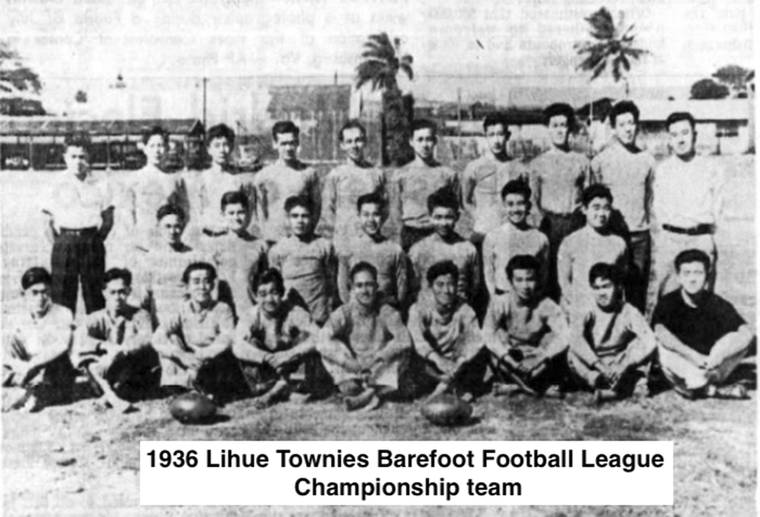From the mid-1920s, through the Great Depression and World War II years, and into the early 1950s, barefoot football occupied a special niche among sports in the Territory of Hawai‘i.
As a matter of fact, it was the most popular game in the territory, drawing great crowds of spectators to single contests.
Thousands of young men, ranging in age from about 15 to 30 on O‘ahu, Maui, Hawai‘i and Kaua‘i, participated in hundreds of barefoot football leagues, which were organized by weight classes with player limits of 120, 130 and 140 pounds, plus one barrel-weight league with a 175 pound limit.
They wore no shoes, no shoulder and hip pads and no protective head gear, but were otherwise equipped with T-shirts, rolled-up denim trousers, and at least on Kaua‘i, sailor hats with the brims turned down.
Tricky reverses, multiple passes and deception plays were the mainstays of barefoot football, with punting being the game’s forte.
It was commonplace for barefoot punters to average 50 yards over an entire season, and 60- to 70-yard punts were not uncommon.
Bill Flazer of Palama, O‘ahu, once punted a 100-yarder at Honolulu Stadium — that’s 80 yards in the air and 20 on the roll.
And, in 1982, former Kaua‘i barefoot player Gene Layosa recalled that one 128-pound guy punted for an average of 50 yards a game and could punt 60 yards with ease.
Layosa also remembered a Kaua‘i player who zigzagged about 150 yards without gaining a yard, until he finally threw the football cross-field 60 yards for a touchdown.
Mainland coaches visiting Hawai‘i described barefoot football as the “fastest, wildest, scrappiest brand of football in the United States.”
When legendary Notre Dame football coach Knute Rockne visited Hawai‘i, he commented that if his Notre Dame gridders could play as fast and as deceptively as the Hawai‘i barefoot players, they would defeat any team in the country.
Other Kaua‘i barefoot football players of note were Mac Kawamura, Joe Souza, Akio Kubota, Tom Murashige, Welcome Albao, Jabby Higuchi, Clarence Kauahi, Angel Dobashi, Taku Akama, Joe Shiramizu and Ike Okamura.
•••
Hank Soboleski has been a resident of Kauai since the 1960s. Hank’s love of the island and its history has inspired him, in conjunction with The Garden Island Newspaper, to share the island’s history weekly. The collection of these articles can be found here: https://bit.ly/2IfbxL9 and here https://bit.ly/2STw9gi Hank can be reached at hssgms@gmail.com




